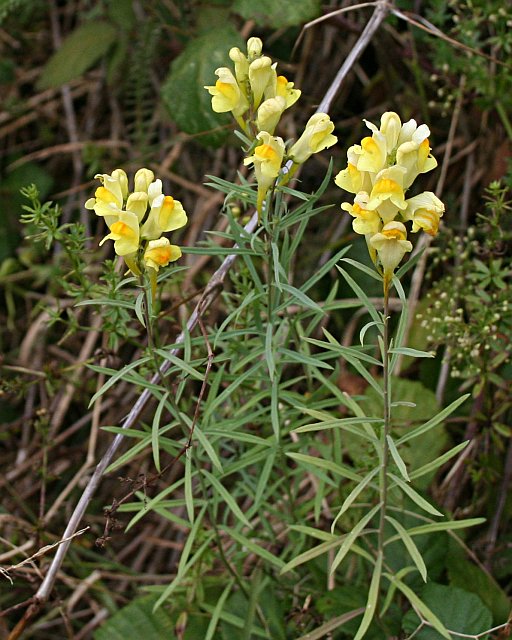Linaria vulgaris
Description
- Herbaceous perennial
- Pale green stems and leaves
- Yellow snapdragon-like flowers with distinctive orange spots
- Stems: Woody at base, smooth towards top, 1 to 3 feet tall
- Leaves: Linear, narrow, 1 to 2 inches long, mainly alternate
- Seeds: Dark brown to black, flattened with papery circular wing
- Common Names: Yellow toadflax, butter-and-eggs, common toadflax
- Habitats: Cultivated fields, pastures, roadsides, and disturbed areas throughout BC
Comparison:
- Differentiated from Dalmatian toadflax by narrow linear leaves (Dalmatian has broad, heart-shaped leaves)
- Easily confused with leafy spurge before flowering (toadflax stems lack milky latex)
Introduction and spread
- Introduced from Europe and Asia
- Spreads primarily through an extensive creeping root system (rhizomes)
- 2-3 week old seedlings can produce creeping roots
- Ability to form large colonies, crowding out other vegetation
Consequences of invasion
Effects on Habitats:
- Impacts rangelands, pastures, cropland, disturbed areas, and roadsides
- Displaces existing plant communities and associated wildlife
- Avoided by cattle, reducing desirable forage plants
Social Impact:
- Unpalatable to livestock
- Invades pastures and grazing fields
Ecological Impact:
- Displaces native forage plants, wildflowers, and grasses
- Reduces biodiversity
- Toxic to wildlife
Economic Impact:
- Reduces foraging area for livestock
- Host for plant diseases like cucumber mosaic virus and broad bean wilt virus
Status in the CKISS region
- Yellow / Common toadflax has become widespread in the CKISS region and is currently classified as Strategic Control on the CKISS Annual Priority List.
- While it is not realistic to eradicate this species at the landscape level, this species may be treated at high priority sites (e.g. wildlife habitat, corridors of spread, adjacent to agricultural land, restoration sites, etc.) based on specific land management objectives.
- To learn more about how CKISS classifies and manages invasive species, see our Invasive Species Priority Lists page.
Integrated pest management options
Prevention
- Become PlantWise and learn about Grow Me Instead. Select alternative, non-invasive plants.
- Regularly monitor properties for weed infestations.
- Ensure soil and gravel are uncontaminated before transport.
- Avoid unloading, parking, or storing equipment in infested areas.
- Remove plant material from equipment, vehicles, or clothing and wash them at designated cleaning sites before leaving infested areas.
- Minimize soil disturbances using grazing plans to prevent soil exposure.
- Use dense, early colonizing seed mixes (e.g., alfalfa or barley) to revegetate exposed soil and resist invasion.
- Bag or cover plants, especially flowering heads or root fragments, during transport to designated disposal sites. Do not compost yellow toadflax.
Mechanical control
- Hand-pull small patches or individual plants, ensuring the entire root mass is removed, especially in soft soils.
- Cultivate infested areas, starting in early June and repeating every 7 to 10 days.
- Avoid cutting, mowing, or burning, as these methods do not kill the plant and may encourage growth.
- Dispose of removed plant material in a plastic bag at the landfill.
Chemical control
- Chemical control may be an option. Consult a professional to determine whether this option is right for you.
- Apply herbicides during flowering when carbohydrate reserves in the root are at their lowest.
- Repeated applications are necessary, with a minimum of three years of treatment.
- Ensure herbicide application is done by a certified professional, following all relevant laws, regulations, and guidelines.
Biological control
Several biological control agents can be used, including:
- Stem mining weevil (Mecinus janthinus)
- Defoliating moth (Calophasia lunula)
- Ovary-feeding beetle (Brachypterolus pulicarius)
- Seed capsule-feeding weevils (Gymnaetron antirrhini and Gymnaetron netum)
- Root-boring moth (Eteobalea intermediella)
Success varies, and research is ongoing. Currently, biological control is recommended in specific areas with established agent populations.








